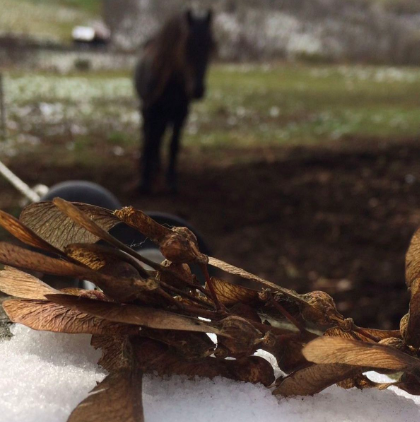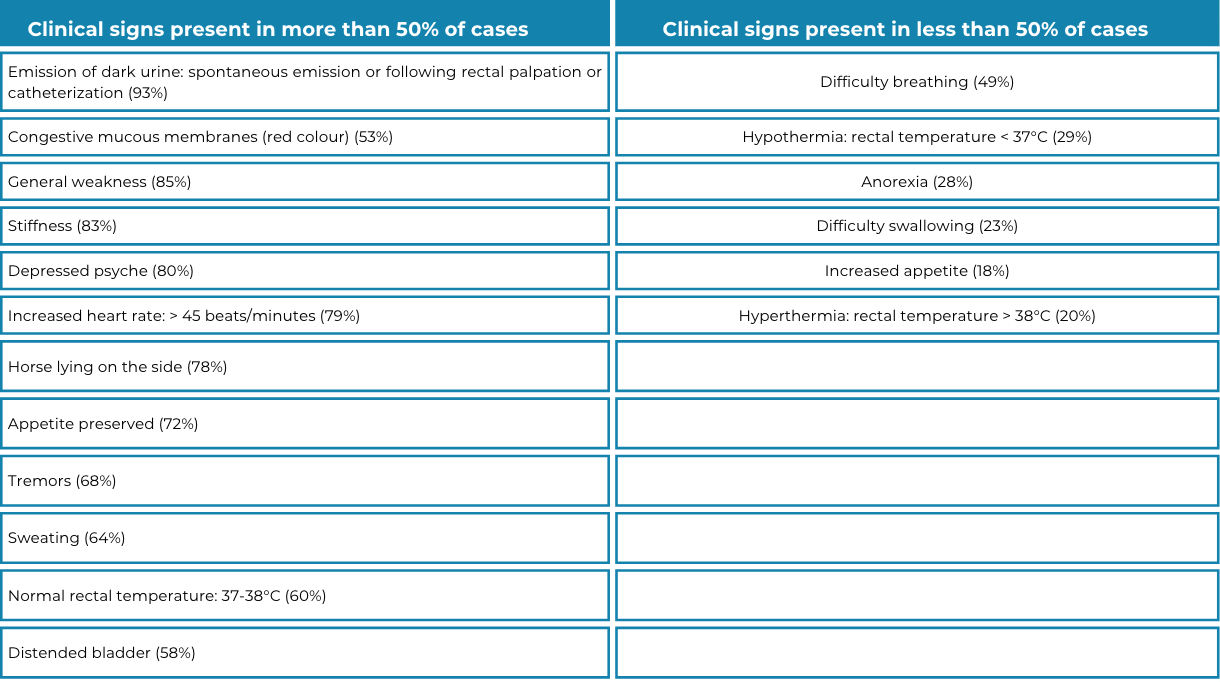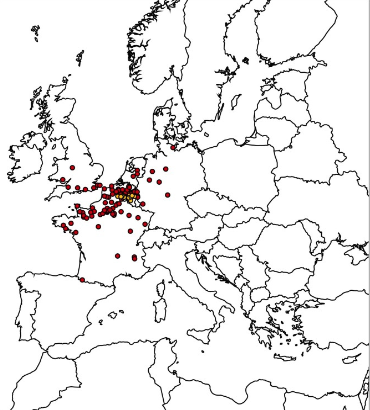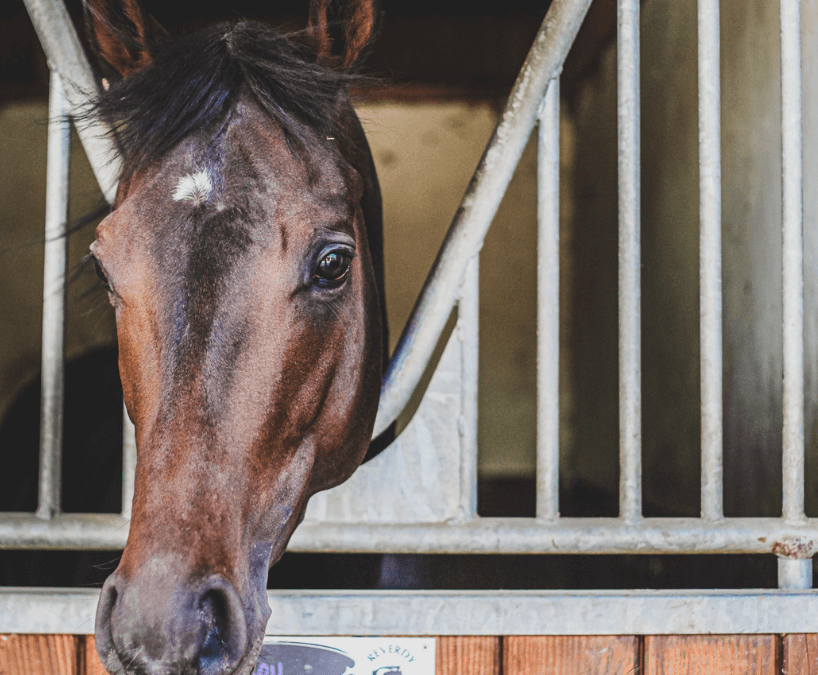Atypical myopathy is a disease that affects horses. It is a generalized muscle weakness caused by the intoxication of a molecule contained in the samaras and seedlings of certain maple trees. When horses graze on pastures where these trees are found, they can ingest toxins that damage muscles and cause muscle failure. Generally fatal in 75% of cases, this disease can occur at any time of year, although it is more common in autumn (¾ of cases) and spring (¼ of cases).
What are the different causes of atypical equine myopathy? Is it possible to prevent this disease? And cure it?
What are the causes of atypical equine myopathy?
Atypical myopathy is caused by the presence of an amino acid called “hypoglycin A” and “methylenecyclopropylglycine“. It is characterized by the destruction of postural, respiratory, and myocardial muscles. This toxin is mainly found in the seeds of certain trees, such as sycamore and Manitoba maple. Horses can therefore ingest this toxin simply by grazing on contaminated pastures or eating contaminated hay or straw. Once ingested, these toxins damage muscle cells and disrupt the horse’s energy metabolism.
Atypical myopathy affects equidae of all species (draught horses, saddle horses, ponies, donkeys, and zebras) that spend most of the day in pasture. The majority of cases spend more than 6 hours a day on the pasture.

What are the symptoms of atypical equine myopathy?
It’s vital to be able to recognise the symptoms of atypical equine myopathy as soon as they appear, as early diagnosis and rapid veterinary intervention can increase the horse’s chances of survival, even though no cure exists.
Symptoms of atypical myopathy can vary depending on the severity of the disease but can include muscle weakness, stiffness, difficulty moving, loss of appetite, muscle pain, tremors, and even respiratory distress.

Important: these symptoms can also be observed in horses with other muscular and neurological conditions, so it is essential to consult a veterinarian for an accurate diagnosis.
How to treat atypical equine myopathy?
The reality is that there is currently no antidote against this disease, and the only good method is prevention, since in ¾ of cases equine myopathy is fatal.
However, symptomatic treatment is available: Administration of vitamins and antioxidants to support muscle function and energy metabolism. Energy intake must be provided by sugars, as the horse’s muscle is temporarily unable to use lipids.
A supportive treatment protocol can be implemented:
- Administer analgesics to combat pain.
- Put the horse on a perfusion drip to maintain and restore hydration and support the kidneys.
- Probe the horse’s bladder, as the toxin may cause urinary retention.
- Respiratory support
- Antioxidants and nutritional supplements may also be prescribed to help reduce muscle damage. In some cases, surgery may be required to remove necrotic muscle tissue.
Can atypical equine myopathy be prevented?
Preventing the presence of samaras on pastures is a difficult task. Even if you avoid planting maples close to grassland, seed dispersal by wind remains significant, reaching distances of up to over 100 meters from the tree. But here are a few tips to prevent the disease:
- Avoid letting your horses graze on pastures where sycamore maples are present.
- Make sure your horses have adequate access to fresh grass and a balanced diet.
- Monitor your horse carefully for any symptoms of atypical myopathy, and consult a veterinarian immediately if in doubt.
- Maintain a clean and safe environment for your horses, by removing potentially toxic plant debris.
- You can also report a case, stay informed, and receive alerts on the presence of these toxins on the Université de Liège website: https://www.myopathie-atypique.uliege.be/cms/c_4322323/en/myopathie

https://equipedia.ifce.fr/en/
What are the consequences of atypical equine myopathy?
Permanent muscle damage is a common problem in horses with AD. Horses can develop areas of muscle fibrosis which can lead to muscle stiffness and reduced flexibility. This stiffness can make exercise difficult for the horse, which can impact his ability to perform in competition.
This disease can also lead to neurological deficits, developing muscle weakness, paralysis, or ataxia, which can affect their ability to move and stand. In the most severe cases, horses may be unable to stand without assistance and may need to be euthanized.
More generally, horses suffering from atypical myopathy may have a weakened immune system, which increases the risk of developing other diseases.
Conclusion
Atypical equine myopathy is a serious disease that significantly affects the well-being and quality of horses. This disease even puts their lives at risk. Finally, the best way to effectively treat atypical myopathy is vigilance. But what is the situation in Europe?
Since 2005, an alert network has been established to monitor atypical myopathy, known as AMAG (Atypical Myopathy Alert Group). This network was initiated and is managed by the University of Liège in Belgium and brings together European researchers and clinicians who are dealing with issues related to this disease.
In France, since the first cases appeared in 2002, the Réseau d’Epidémio-Surveillance en Pathologie Equine (RESPE) has actively participated in the European network.

https://respe.net/maladie-equine/maladies-du-paturage/myopathie-atypique/
Autumn is a high-risk season for atypical equine myopathy. For practical information, we invite you to read the article “Answers to Frequently Asked Questions (FAQs) about equine feeding and management, and pasture management to reduce the risk of atypical myopathy”, freely downloadable via this link http://hdl.handle.net/2268/245399, as well as its appendices (explanatory sheet: “How to recognize the maples of our regions”: http://hdl.handle.net/2268/242222).
Encourage your acquaintances to report cases to the Atypical Myopathy Alert Group and RESPE:
– as an owner, via the link :
https://urlz.fr/jjCs
– as a veterinarian, via the link :
https://urlz.fr/jjCv
– as a veterinarian (cases occurring in France), via the link :
https://respe.net/You’ll be helping the research.
Further information:
http://www.myopathie-atypique.be
https://equipedia.ifce.fr/en/equipedia-the-universe-of-the-horse-ifce/health-and-animal-well-being/diseases/musculoskeletal-sytem/equine-atypical-myopathy-eam
https://respe.net/
SOURCES :
Ifce.fr. (2023). Available at: https://equipedia.ifce.fr/sante-et-bien-etre-animal/maladies/appareil-locomoteur/myopathie-atypique [Accessed 4 Aug. 2023].
Respe – Réseau d’Epidémio-Surveillance en Pathologie Équine. (n.d.). Myopathie atypique. [online] Available at: https://respe.net/maladie-equine/maladies-du-paturage/myopathie-atypique/#:~:text=Cette%20maladie%20est%20une%20intoxication [Accessed 4 Aug. 2023].
Baise, E., Habyarimana, J.A., Amory, H., Boemer, F., Douny, C., Gustin, P., Marcillaud-Pitel, C., Patarin, F., Weber, M. and Votion, D.-M. . (2015). Samaras and seedlings ofAcer pseudoplatanusare potential sources of hypoglycin A intoxication in atypical myopathy without necessarily inducing clinical signs. Equine Veterinary Journal, 48(4), pp.414–417. doi:https://doi.org/10.1111/evj.12499. https://www.classequine.com/fiches-maladies/myopathie-atypique-du-cheval/. https://www.myopathie-atypique.uliege.be/cms/c_4322323/en/myopathie
Keywords: equine myopathy, maple, muscle cells, atypical myopathy, etc.
Photo credit: @eleonoregroux

